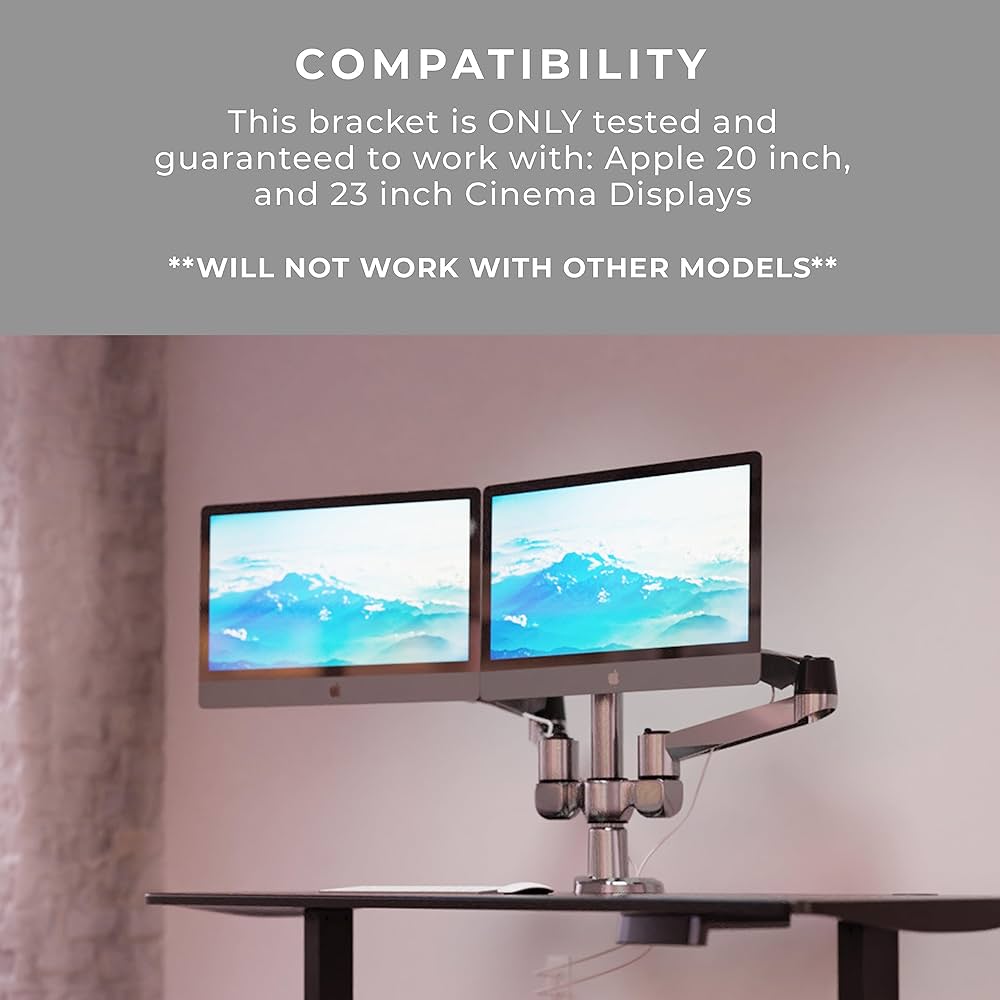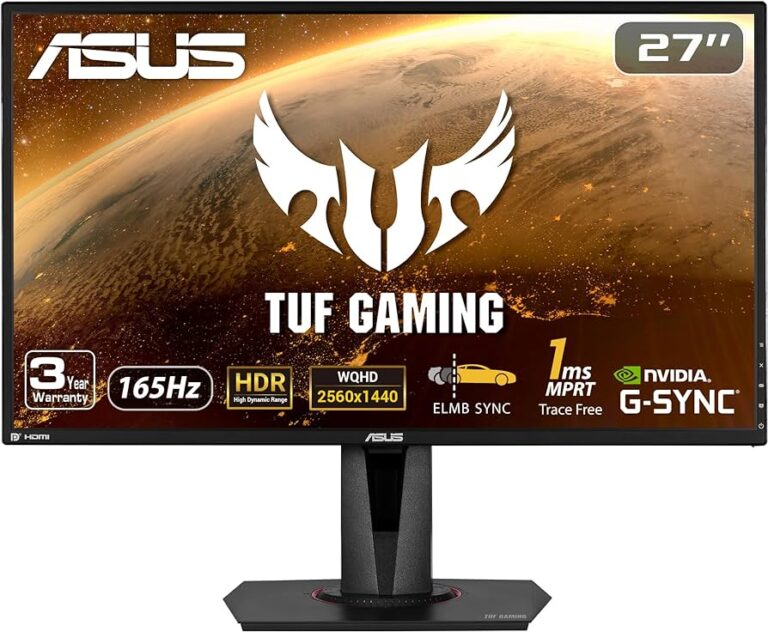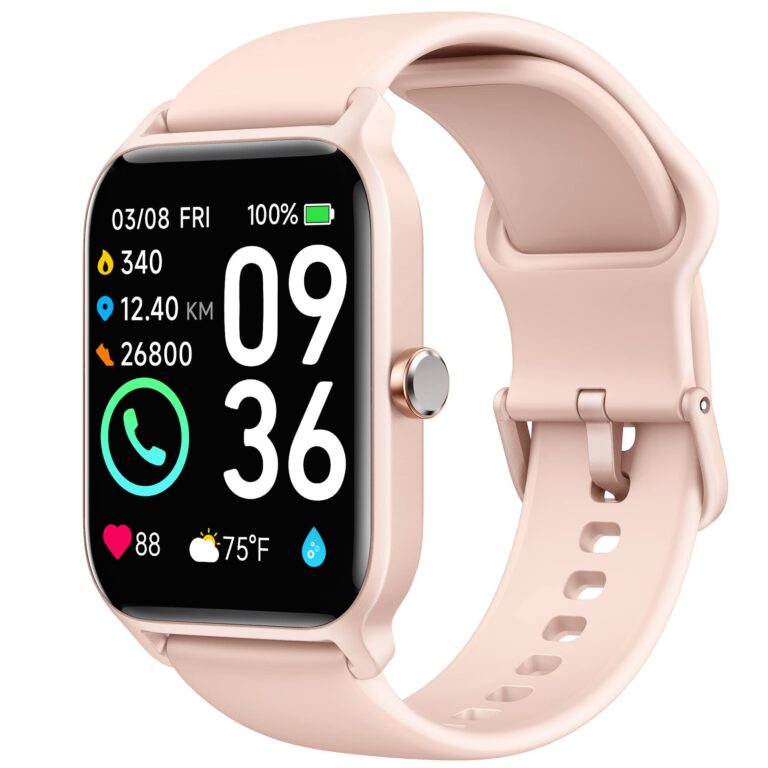Vertical Stand: Why It’s Not Compatible with 23 Monitor
The vertical stand is not compatible when used with a 23 monitor. Stability issues are a common frustration when using monitor arms, often causing a noticeable bounce.
While almost any decent monitor is Vesa mount compatible and will work with stands/arms, there may still be compatibility issues with specific sizes or models. It is important to carefully consider the specifications and requirements of both the monitor and the stand before making a purchase.
Additionally, some monitors may not have a Vesa mount, which can limit options for vertical mounting. It is recommended to do thorough research and consult with experts to find the best solution for your specific monitor and stand needs.

Credit: www.amazon.com
Unveiling Monitor Design Limitations
When it comes to mounting a monitor vertically, there are certain design limitations that you need to be aware of. Understanding the standard monitor design, why some monitors aren’t VESA mount compatible, and the physical constraints of 23″ monitors will help you make an informed decision. Let’s dive into the details.
Understanding The Standard Monitor Design
Monitors are designed to be versatile and often feature a VESA mount compatibility. This allows users to easily attach their monitors to various stands, arms, or brackets. However, not all monitors adhere to this standard design, leading to compatibility issues with certain mounts. Let’s explore the reasons behind this.
Why Some Monitors Aren’t Vesa Mount Compatible
While most monitors are VESA mount compatible, there are monitors that do not conform to this standard. Manufacturers may choose not to include VESA mounting holes or brackets in their designs for aesthetic or cost-saving reasons. These monitors often come with their proprietary stands or limited mounting options. As a result, finding a suitable mount for these monitors can be challenging.
Physical Constraints Of 23″ Monitors
When it comes to 23″ monitors specifically, there are additional physical constraints to consider. These monitors are relatively smaller in size compared to larger displays, which means that the available space for mounting solutions is limited. The compact design may not allow for traditional VESA mounting options, further restricting your choices when it comes to finding a compatible vertical stand.
In conclusion, it’s important to recognize the limitations imposed by monitor designs when it comes to mounting them vertically. Not all monitors are VESA mount compatible, and 23″ monitors have their unique physical constraints. Understanding these limitations will help you choose the right mounting solution for your specific monitor model.
Vertical Stand: Match With 23 Monitors
The Vertical Stand is not compatible when used with up to 23 monitors. It is important to ensure that the monitor is VESA mount compatible to avoid any compatibility issues when using a vertical stand.
Importance Of Vesa Compliance In Compatibility
When it comes to finding a suitable vertical stand for your 23″ monitor, it is crucial to consider VESA compliance. The VESA (Video Electronics Standards Association) standard ensures that the mounting holes on the back of your monitor are compatible with various stands and arms in the market. By adhering to this standard, you can easily find a vertical stand that matches your 23″ monitor without any physical compatibility issues.
The Physical Incompatibility Of Certain 23″ Models
While most 23″ monitors adhere to the VESA standard, there are some models that may not be compatible due to their unique physical design. These non-compliant models may have different hole patterns or lack the necessary mounting holes altogether. It is essential to check the specifications of your monitor to ensure VESA compatibility before purchasing a vertical stand.
How To Identify Compatible Vertical Stands
To ensure compatibility between your 23″ monitor and a vertical stand, here’s how you can identify suitable options:
- Check your monitor’s specifications or user manual for VESA compatibility information.
- Measure the distance between the mounting holes on the back of your monitor. The VESA pattern is expressed in millimeters (e.g., 75x75mm or 100x100mm).
- Search for vertical stands or monitor arms that mention compatibility with your specific VESA pattern.
- Read reviews or consult customer support to confirm compatibility between your monitor model and the vertical stand you are considering.
By following these steps, you can ensure a perfect match between your 23″ monitor and a compatible vertical stand, allowing you to enjoy the benefits of a vertical setup with ease.
Engineering Behind Monitor Stands
The engineering behind monitor stands ensures compatibility for most monitors, but vertical stands may not be compatible with monitors larger than 23 inches.
Basic Principles Of Monitor Stand Design
When it comes to the engineering behind monitor stands, there are some basic principles that designers adhere to. The main goal of any monitor stand design is to provide stability and flexibility for optimal viewing angles and comfort. These stands are designed to securely hold monitors in place, preventing wobbling or sagging while allowing users to adjust the height, tilt, and swivel to their desired position.
The materials used in monitor stand construction are typically lightweight yet durable, ensuring that the stand can support the weight of the monitor without compromising its stability. Many stands also incorporate cable management solutions to keep the workspace clutter-free.
Why Vertical Stands May Fail With 23″ Monitors
Vertical stands are an excellent option for those who prefer a vertical monitor orientation. However, it is important to note that not all vertical stands are compatible with 23″ monitors. The size and weight of the monitor can impact the stability and functionality of the stand.
With a 23″ monitor, the weight distribution may not align with the design specifications of some vertical stands, leading to instability and potential sagging. The stand may struggle to securely hold the monitor in place, resulting in an unreliable or frustrating user experience.
Additionally, the dimensions of a 23″ monitor may not fit well within the vertical stand’s clamp or brackets, which could further compromise its stability.
Therefore, it is crucial to ensure that the chosen vertical stand is specifically designed to accommodate 23″ monitors, considering both their weight and dimensions. This will help eliminate potential stability issues and ensure a seamless integration between the stand and the monitor.
The Shift Towards Universal Compatibility
In recent years, there has been a shift in monitor stand design towards universal compatibility. Manufacturers understand the importance of ensuring that their stands can support a wide range of monitor sizes and weights, including 23″ monitors.
By implementing adjustable features, such as VESA mounts with various hole patterns, universal compatibility has become more achievable. This allows users to easily find a compatible monitor stand for their specific monitor size, regardless of whether it is horizontal or vertical orientation.
Universal compatibility not only offers convenience to users but also minimizes the risk of stability issues and enhances the overall user experience. It ensures that regardless of the monitor size or orientation, users can find a reliable and secure stand that meets their needs.
The Stability Factor In Vertical Stands
The stability factor is crucial when using a vertical stand for a 23 monitor. Make sure to choose a compatible stand that can securely hold the monitor in place without any wobbling or instability.
How 23″ Monitors Affect The Stability Of Stands
When it comes to vertical stands, stability is a crucial factor to consider. The size and weight of the monitor can greatly affect the stability of the stand. In the case of 23″ monitors, their dimensions and weight can pose a challenge for vertical stands. Due to their larger size and weight, 23″ monitors can cause the stand to be less stable, leading to wobbling or even tipping over.
To ensure maximum stability, it is important to choose a vertical stand that is specifically designed to support 23″ monitors. These stands are built with sturdy materials and a solid base to provide the necessary support for larger monitors. By opting for a stand that is compatible with 23″ monitors, you can rest assured that your monitor will be securely held in place, minimizing the risk of accidents or damage.
Designing For Durability And Support
When it comes to vertical stands, durability and support are key considerations. A well-designed stand should be able to withstand the weight and pressure exerted by a 23″ monitor, ensuring that it remains stable and secure. Manufacturers take into account the specific requirements of larger monitors when designing these stands, using materials and construction techniques that provide the necessary strength and stability.
Additionally, vertical stands for 23″ monitors often incorporate features such as adjustable height and tilt, allowing you to find the most comfortable viewing angle. This not only enhances your viewing experience but also contributes to the overall stability of the stand. By being able to adjust the position of your monitor, you can minimize strain on the stand and ensure that it remains secure even during extended use.
Potential Risks Of Using Incompatible Stands
Using a vertical stand that is not compatible with your 23″ monitor can pose several risks. Firstly, the stand may not be able to hold the monitor securely, leading to instability and the possibility of the monitor tipping over. This can result in damage to both the monitor and any surrounding equipment. Additionally, an incompatible stand may not provide adequate support for the weight of the monitor, causing the stand to buckle or break under the pressure.
Another potential risk is the strain exerted on the monitor itself. When a stand is not specifically designed for a 23″ monitor, it may place undue stress on the monitor’s frame or internal components. This can lead to issues such as screen damage, decreased performance, or even complete malfunction.
To avoid these risks, it is crucial to ensure that your vertical stand is compatible with your specific 23″ monitor. Always check the manufacturer’s specifications and recommendations before purchasing a stand, and choose one that is designed to provide the necessary stability and support for your monitor’s size and weight. Taking these precautionary measures will help ensure the safety of your monitor and prolong its lifespan.
Alternative Solutions For Vertical Use
When it comes to using a vertical stand with a 23″ monitor, compatibility issues can arise. Not all monitors are designed to work with vertical stands, which can be frustrating if you prefer a vertical setup. However, there are alternative solutions you can explore to achieve a vertical orientation for your monitor. Whether you are looking for a DIY approach, a multi-monitor stand, or considering a new monitor altogether, there are options to suit your needs.
Diy Approaches To Vertically Orient A 23″ Monitor
If you are on a budget or enjoy a hands-on approach, there are several DIY methods you can try to vertically orient your 23″ monitor. While these approaches may not provide the same stability as dedicated stands, they can be a temporary solution or suit those with limited resources. Here are a few ideas to consider:
- Use tape or adhesive materials to secure your monitor in a vertical position
- Build a custom stand using wooden blocks or other materials
- Repurpose an existing stand or mount by modifying it to fit your vertical needs
Exploring Multi-monitor Stands For Vertical Setups
If you are interested in a more professional and stable solution, multi-monitor stands designed for vertical setups can be an excellent choice. These stands are specifically designed to accommodate multiple monitors and provide adjustable configurations. Look for VESA mount compatibility to ensure your 23″ monitor can be securely attached. With a multi-monitor stand, you can create a sleek and organized vertical setup that maximizes your workspace.
When To Consider A New Monitor For Vertical Use
If you find that your current monitor is not compatible with vertical stands, it may be worth considering investing in a new monitor that is designed for vertical use. Look for monitors with built-in adjustable stands or VESA mount compatibility. Upgrading to a monitor that is specifically designed for vertical orientation can offer improved stability and ergonomics. Assess your needs and budget to determine if purchasing a new monitor is the right solution for you.
Remember, finding alternative solutions for vertical use can help you optimize your workspace and improve your productivity. Whether you choose a DIY approach, explore multi-monitor stands, or consider a new monitor, there are options available to suit your needs and preferences.
Frequently Asked Questions For Vertical Stand Is Not Compatible When Used With To 23 Monitor
Do All Monitor Stands Fit All Monitors?
No, not all monitor stands fit all monitors. Compatibility depends on the VESA mounting standard of the monitor and the stand’s specifications. It is important to check the VESA compatibility and weight capacity of both the monitor and the stand before purchasing.
Are All Monitors Vertical Compatible?
Not all monitors are vertical compatible. You need to check if your monitor has a VESA mount or an adjustable stand that allows it to be rotated vertically. If your monitor doesn’t have these features, you may need to use additional accessories like stands, arms, or tape to make it vertical.
Can All Monitors Be Mounted Vertically?
Yes, almost all monitors can be mounted vertically, as long as they are VESA mount compatible. Whether you have a monitor stand or arm, they can hold the monitor securely in a vertical position. Some monitors may require additional accessories if they don’t have a VESA mount.
Is 24 Inch Monitor Good For Vertical?
Yes, a 24-inch monitor can be good for vertical usage. It is important to check if the monitor is Vesa mount compatible, as most monitor stands and arms require this feature. Some monitors may also come with a swivel stand to easily switch between landscape and portrait modes.
However, stability issues can occur with monitor arms, so it is recommended to do research before purchasing one.
Conclusion
To conclude, it is important to note that not all monitors are compatible with vertical stands. While almost any decent monitor is VESA mount compatible, which allows for the use of stands and arms, stability issues can be a major frustration when using monitor arms.
It is crucial to ensure the monitor is the right weight and size for the stand to prevent sagging or instability. Additionally, not all monitors can be adjusted to both landscape and portrait orientations. Therefore, it is essential to choose a monitor stand or arm that is suitable for your specific monitor to ensure optimal functionality and stability.






